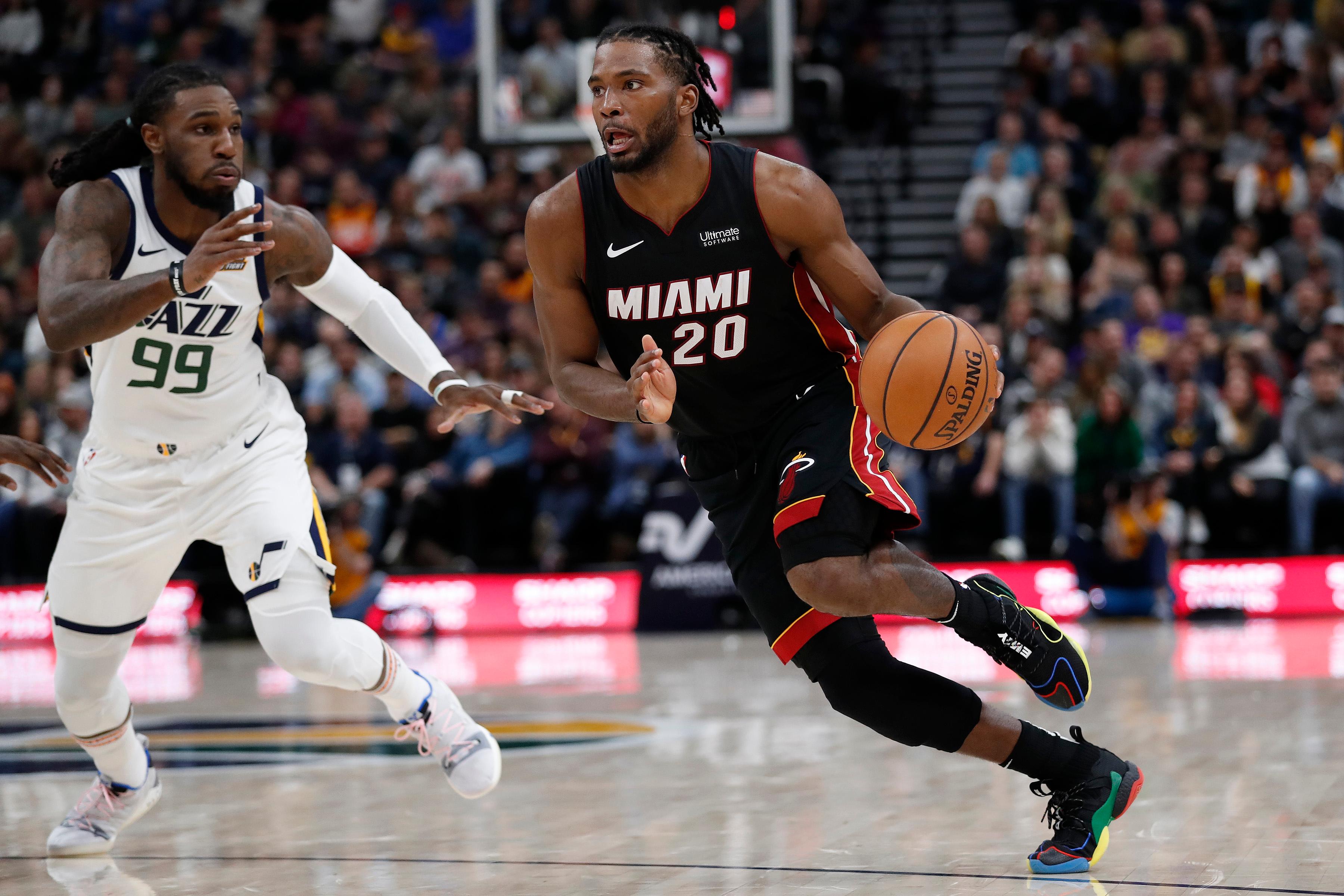
Imagine superstar Kawhi Leonard guarding young Kawhi Leonard—a Kawhi without a ring, a Finals MVP, or an offensive skill set—and failing to contain him. Then watch this play from the Raptors-Heat game on Wednesday night:
Throughout Justise Winslow’s four-year career, he’s carried the same reputation as the young Kawhi: advanced defensively, but underdeveloped on the other end. Miami lost to Toronto on Wednesday, 106-104, and the dribble-driving Winslow above was the same one who missed a 26-footer with 2.8 seconds to go. But more telling was his decision to take the shot: He grabbed the offensive board, retreated, and took the Heat’s fate into his own hands. What’s different about Winslow this season, other than being on the floor in crunch time at all, is that he shouldered that burden comfortably. In the month of December, the ball (and the Heat’s fate) have been in Winslow’s hands more than ever before.
”He is our starting point guard. That’s what I told him. I told our team that,” Erik Spoelstra said of Winslow heading into Wednesday’s game. “It’s a big responsibility. He loves those type of challenges. I don’t want to put a ceiling on it.” Spoelstra hadn’t officially put a label on it before then, either. Winslow has filled in at the 1 spot sporadically this season, most recently for the last five games in place of Goran Dragic, who is recovering from knee surgery. During that stretch, Miami was undefeated.
The Raptors broke that streak on Wednesday and re-exposed the Heat’s flaws. Spoelstra has no go-to scorer; the closest he has to a closer is Dwyane Wade, who is in the midst of a retirement tour. (And whose missed Danny Green assignment followed by a ridiculous, contested deep 3 ensured Miami’s defeat against Toronto.) Winslow is not that go-to scorer. But without him, Spoelstra would be short a quarterback as well. The Heat coach could run a seven-man rotation of purely shooting guards (Josh Richardson, Tyler Johnson, Rodney McGruder, Wade, Wayne Ellington, and Dion Waiters, who’s currently injured), but he has no clear backup to run point. So far, Johnson and Ellington have also been employed to start in Dragic’s place. But Winslow has best kept the team afloat, and he’s done it by changing the offense’s pace to fit better inside of it.
With Dragic on the floor, Miami tries to take advantage of its team speed and transition because it relies on drives for points. The drive-and-kick was perfected by the Dragic-Waiters tag team in the latter half of the 2016-17 season, when the Heat went on its 30-11 run after starting 11-30. That style doesn’t fit Winslow, who’s already playing catch-up on the offensive end. In the past, he has been forced to make quick decisions rather than calculated ones, and for a player with poor touch around the rim, being selective is crucial. Dragics, Curry, and Irving, however, can make it up as they go. Through November 14, Dragic’s last appearance, the Heat operated at the 10th-highest pace in the league. Since he’s been out, they’ve dropped to 25th; and since Winslow became chief mechanic, they’ve dropped to 29th. Only the Grizzlies play slower. Miami has scored 109 points per 100 possessions through this recent 5-1 stretch, which is a better figure (albeit in a smaller sample size) than Dragic’s time at the one, and much better than with any of the other Dragic backups.
Meanwhile, Winslow’s individual scoring is at a career best. In December, he averaged 14.4 points on 49.2 percent shooting overall and 45.3 percent from the perimeter. His touch is beginning to show refinement; he’s hitting midrange jumpers and taking more 3s, but he’s also sinking floaters and improved his finishing around the rim. As much as Miami has bent toward his pace, he’s also conformed to the team’s original identity: effective drive-and-kick.
The Heat have attacked the basket less since Winslow took over, but he’s making something out of situations he used to throw away. Since he’s started at point guard, Winslow has finished shots off drives at a 61.1 percent clip (as compared to 43 percent last season), and is passing out of them 39.5 percent of the time. He is handing open opportunities for his teammates in true Heat playmaking form. Winslow is demonstrating increased creativity with reads. Connections with Bam Adebayo are practically automatic, a good sign for the future.
The light at the end of the tunnel for Miami wasn’t expected to be Point Winslow. It’s unlikely that’s what Pat Riley saw in the Duke product when he selected a combo forward with a 6-foot-10 wingspan and no offensive game 10th overall in 2015. (Though with Spoelstra dreaming up the lineups, don’t rule out any position for a player. Winslow has been tried at every spot during his time in Miami.) The first sign of real growth was Winslow’s performance during the 2018 first-round series against Philadelphia, which caused some to wonder what he could be if he went somewhere else. That speculation continued this summer, when Winslow was mentioned in trade packages to bring Jimmy Butler to the Heat. (Ironically, Butler’s lack of offense coming into the league was another Leonard-esque example for Winslow to consider.) The answer to “What’s Winslow’s ceiling?” didn’t necessarily involve Miami, despite Winslow re-signing with the team on a three-year, $39 million extension this October.
It was uncharacteristic of Riley to let a summer to come and go without making any major moves to a team that was in need of change. He repeatedly mentioned that Miami needed to grow “organically.” It takes time. Ask Justise. Sometimes, it takes more than three years.